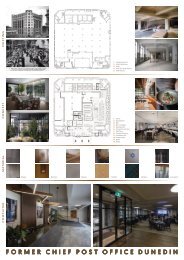ESSR Musculoskeletal Ultrasound Technical Guidelines I. Shoulder
Create successful ePaper yourself
Turn your PDF publications into a flip-book with our unique Google optimized e-Paper software.
European Society of
MusculoSkeletal Radiology
Musculoskeletal Ultrasound
Technical Guidelines
I. Shoulder
Ian Beggs, UK
Stefano Bianchi, Switzerland
Angel Bueno, Spain
Michel Cohen, France
Michel Court-Payen, Denmark
Andrew Grainger, UK
Franz Kainberger, Austria
Andrea Klauser, Austria
Carlo Martinoli, Italy
Eugene McNally, UK
Philip J. O’Connor, UK
Philippe Peetrons, Belgium
Monique Reijnierse, The Netherlands
Philipp Remplik, Germany
Enzo Silvestri, Italy
Shoulder
1
Although patient’s positioning for shoulder US varies widely across different Countries and
Institutions reflecting multifaceted opinions and experiences of different examiners, we
strongly recommend to examine the patient while seated on a revolving stool. This position
allows the examiner to reach the anterior, lateral and posterior aspects of the shoulder
with the probe by simply asking the patient to rotate on the chair.
2
Place the arm in slight internal rotation (directed towards the contralateral knee) with the
elbow flexed 90°, palm up. Start by finding the long biceps tendon in between the greater
and lesser tuberosities – Use short and long (more limited utility) axis planes to examine
the biceps.
SubS
LT
GT
Shift the probe up to examine the biceps in its intraarticular course and down to reach the
myotendinous junction (level of the pectoralis major tendon).
SubS
SupraS
SH
LH
H
Legend: SubS, subscapularis tendon; SupraS, supraspinatus tendon; Arrow, long head of the biceps tendon;
LT, lesser tuberosity; GT, greater tuberosity; SH, short head of the biceps; LH, long head of the biceps; H,
humeral shaft; Arrowheads, pectoralis major tendon
1
Shoulder
3
Rotate the arm externally fixing the elbow on the iliac crest to show the subscapularis tendon
and its insertion on the lesser tuberosity (slight supination of the hand may be helpful
to neutralize the tendency to lift and abduct the elbow from the lateral chest wall).
Del
Co
SubS
LT
This tendon should be evaluated along its long- (transverse planes) and short- (sagittal
planes) axis during passive external and internal rotation with hanging arm. Sweep the
transducer up and down over the subscapularis until its full width is demonstrated.
SubS
LT
LT
Legend: Arrow, long head of the biceps tendon; dashed line, insertion of the subscapularis tendon; Co, coracoid;
Del, deltoid muscle; LT, lesser tuberosity; SubS, subscapularis tendon; void arrowheads, tendon fascicles
of the subscapularis; white arrowheads, muscle tissue interposed between tendon fascicles
2
Shoulder
4
Moving the probe toward medial on transverse planes, look at the coracoid process, the
coracoacromial ligament (the medial margin of the transducer is on the coracoid process
and the lateral edge is shifted upward and laterally towards the acromion), the conjoined
tendon and the anterior aspect of the subacromial subdeltoid bursa. Then, check the subscapularis
recess and the subcoracoid bursa for effusion. External and internal rotation
may also used to demonstrate anteromedial impingement (distance between coracoid process
and lesser tuberosity measured in internal rotation).
CoBr
SubS
HH
Co
SupraS
Acr
Legend: Acr, acromion; Arrows, short head of the biceps; Arrowheads, coracoacromial ligament; Co, coracoid;
CoBr, coraco-brachialis; HH, humeral head; SubS, subscapularis tendon; SupraS, supraspinatus
5
Place the patient’s arm posteriorly,
placing the palmar side of the
hand on the superior aspect of
the iliac wing with the elbow flexed
and directed posteriorly. The
supraspinatus tendon should be
evaluated along its long- and
short-axis.
3
Shoulder
5
Refer to the intraarticular portion of
the biceps as a landmark to obtain
proper transducer orientation for
imaging the supraspinatus. In fact,
these tendons run parallel one to
the other and the intraarticular portion
of the biceps is easy to be recognized
due to a more clearly defined
fibrillar pattern. One should rotate
the transducer until the biceps
is depicted as more elongated as
possible in the US image. Then, the
probe is shifted upward and posteriorly
over the supraspinatus without
changing its orientation. The resulting
image is in axis with the supraspinatus.
Between the supraspinatus
and the deltoid, the normal subacromial-subdeltoid
bursa appears
as a thin hypoechoic band.
Acr
*
Del
SupraS
GT
Del
SupraS
Tilt the transducer gently in the area overlying the tendon insertion to avoid anisotropy.
Remember to scan the lateral pouch of the subacromial subdeltoid bursa along the lateral
edge of the greater tuberosity. When looking for the supraspinatus on short-axis, the normal
cuff must have almost the same thickness from the biceps tendon landmark until 2cm
backwards: from this point backwards the tendon seen is the infraspinatus.
Legend: Acr, acromion; asterisk, myotendinous junction; Del, deltoid muscle; GT, greater tuberosity; void
arrow-head, articular cartilage; curved arrow, hypoechoic artifact related to anisotropy; straight arrow, long
head of the biceps tendon; SupraS, supraspinatus tendon; white arrowhead, subacromial subdeltoid bursa
4
Shoulder
6
Place the dorsum of the hand over the opposite back pocket (forced internal rotation,
stress manoeuvre). There should not be any space gap between the elbow and the lateral
chest wall. Using this position, the supraspinatus becomes a more anterior structure
and the transducer should be oriented almost vertically to be in axis with it. Consider that
the tendon fibers are more stretched than in the position described at point -5. This may
be possible cause of overestimation of tear size. Due to an excessive internal rotation,
the long head of the biceps tendon may be difficult to be visualized in this position.
Neutral
Internal Rotation
7
Dynamic assessment of subacromial (antero-superior) impingement can be attempted by
placing the probe in the coronal plane with its medial margin at the lateral margin of the
acromion. The patient abducts his arm while in internal rotation. With this manoeuvre, the
supraspinatus and the bursa can be seen passing deep to the coracoacromial arch.
Acr
GT
Acr
GT
Legend: Acr, acromion; GT, greater tuberosity;
arrows, supraspinatus tendon
5
Shoulder
8
Place the transducer over the posterior aspect of the glenohumeral joint with the arm in
the same position described at point-2 (or with the hand on the opposite shoulder) and
increase the depth to include the structures of the posterior fossa within the field-of-view
of the US image. Use the spine of the scapula as the landmark to distinguish the
supraspinous fossa (transducer shifted-up) from the infraspinous fossa (transducer
shifted-down) on sagittal planes.
1
2
Legend: a, supraspinatus; arrow, spine of the scapula; b, infraspinatus; c, teres
minor; dashed line, spine of the scapula; 1, supraspinous fossa; 2, infraspinous
fossa; void arrowheads, deltoid; white arrowheads, trapezius
Look at the infraspinatus and teres minor muscles as individual structures filling the infraspinous
fossa deep to the deltoid. After scanning these muscles, sweep the transducer
toward the greater tuberosity on sagittal planes. The two tendons can be appreciated
as individual structures arising from the respective muscles.
*
InfraS
Del
Tm
*
Del
GT
Legend: asterisk, spine of the scapula; dashed line, spine of the scapula; Del, deltoid muscle; GT, greater tuberosity;
InfraS, infraspinatus muscle; Tm, teres minor muscle; void arrow, teres minor tendon; white arrows,
infraspinatus tendon
6
Shoulder
9
Examine these tendons separately on their long-axis (transverse planes) during external
and internal rotation of the arm (same position as in point-2) by placing the probe over
the posterior aspect of the glenohumeral joint.
HH
HH
Look at the posterior labrum-capsular complex
and check the posterior recess of the
joint for effusion during scanning. In thin
subjects the posterior labrum can be clearly
seen. Move the transducer medial to the
labrum on transverse plane to visualize the
spinoglenoid notch. It is often necessary to
increase the depth of the field-of-view not
to miss this area. A paralabral cyst originating
in this area should be sought.
HH
InfraS
*
Legend: asterisk, spinoglenoid notch; curved arrow, bony glenoid; HH, humeral head; InfraS, infraspinatus; void
arrows, teres minor tendon; white arrows, infraspinatus tendon; white arrowheads, posterior labrum
10
Place the transducer in the coronal plane
over the shoulder to examine the
acromioclavicular joint. Sweep the transducer
anteriorly and posteriorly over this
joint to assess the presence of an os
acromiale. Shifting the probe posterior to
the acromioclavicular joint, it is possible
to assess the status of the supraspinatus
muscle.
Cl *
Acr
Legend: Acr, acromion; arrowheads, superior
acromioclavicular ligament; asterisk, acromioclavicular
joint space; Cl, clavicle
7
















